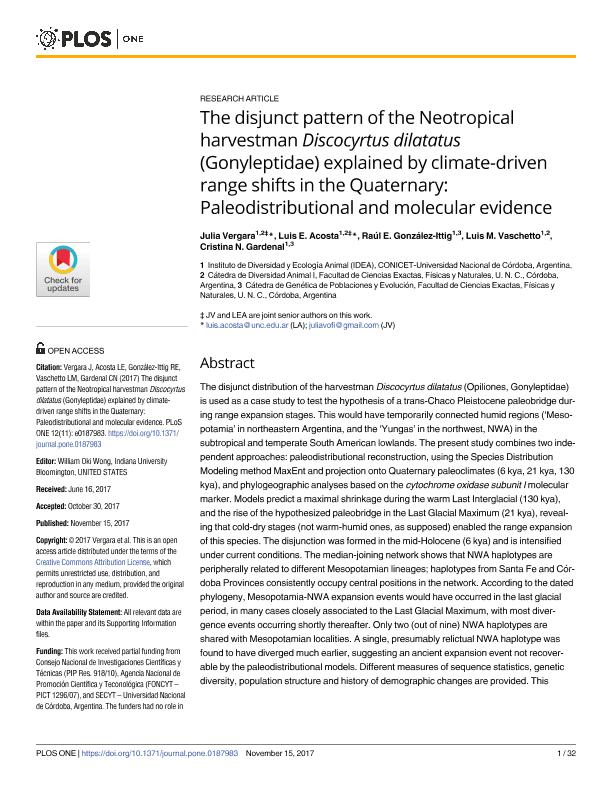Artículo
The disjunct pattern of the Neotropical harvestman Discocyrtus dilatatus (Gonyleptidae) explained by climate-driven range shifts in the Quaternary: Paleodistributional and molecular evidence
Vergara Oficialdegui, Julia ; Acosta, Luis Eduardo
; Acosta, Luis Eduardo ; González Ittig, Raúl Enrique
; González Ittig, Raúl Enrique ; Vaschetto, Luis Maria Benjamin
; Vaschetto, Luis Maria Benjamin ; Gardenal, Cristina Noemi
; Gardenal, Cristina Noemi
 ; Acosta, Luis Eduardo
; Acosta, Luis Eduardo ; González Ittig, Raúl Enrique
; González Ittig, Raúl Enrique ; Vaschetto, Luis Maria Benjamin
; Vaschetto, Luis Maria Benjamin ; Gardenal, Cristina Noemi
; Gardenal, Cristina Noemi
Fecha de publicación:
11/2017
Editorial:
Public Library of Science
Revista:
Plos One
e-ISSN:
1932-6203
Idioma:
Inglés
Tipo de recurso:
Artículo publicado
Clasificación temática:
Resumen
The disjunct distribution of the harvestman Discocyrtus dilatatus (Opiliones, Gonyleptidae) is used as a case study to test the hypothesis of a trans-Chaco Pleistocene paleobridge during range expansion stages. This would have temporarily connected humid regions (‘Mesopotamia’ in northeastern Argentina, and the ‘Yungas’ in the northwest, NWA) in the subtropical and temperate South American lowlands. The present study combines two independent approaches: paleodistributional reconstruction, using the Species Distribution Modeling method MaxEnt and projection onto Quaternary paleoclimates (6 kya, 21 kya, 130 kya), and phylogeographic analyses based on the cytochrome oxidase subunit I molecular marker. Models predict a maximal shrinkage during the warm Last Interglacial (130 kya), and the rise of the hypothesized paleobridge in the Last Glacial Maximum (21 kya), revealing that cold-dry stages (not warm-humid ones, as supposed) enabled the range expansion of this species. The disjunction was formed in the mid-Holocene (6 kya) and is intensified under current conditions. The median-joining network shows that NWA haplotypes are peripherally related to different Mesopotamian lineages; haplotypes from Santa Fe and Córdoba Provinces consistently occupy central positions in the network. According to the dated phylogeny, Mesopotamia-NWA expansion events would have occurred in the last glacial period, in many cases closely associated to the Last Glacial Maximum, with most divergence events occurring shortly thereafter. Only two (out of nine) NWA haplotypes are shared with Mesopotamian localities. A single, presumably relictual NWA haplotype was found to have diverged much earlier, suggesting an ancient expansion event not recoverable by the paleodistributional models. Different measures of sequence statistics, genetic diversity, population structure and history of demographic changes are provided. This research offers the first available evidence for the historical origin of NWA disjunct populations of a Mesopotamian harvestman.
Archivos asociados
Licencia
Identificadores
Colecciones
Articulos(IDEA)
Articulos de INSTITUTO DE DIVERSIDAD Y ECOLOGIA ANIMAL
Articulos de INSTITUTO DE DIVERSIDAD Y ECOLOGIA ANIMAL
Citación
Vergara Oficialdegui, Julia; Acosta, Luis Eduardo; González Ittig, Raúl Enrique; Vaschetto, Luis Maria Benjamin; Gardenal, Cristina Noemi; The disjunct pattern of the Neotropical harvestman Discocyrtus dilatatus (Gonyleptidae) explained by climate-driven range shifts in the Quaternary: Paleodistributional and molecular evidence; Public Library of Science; Plos One; 12; 11; 11-2017
Compartir
Altmétricas



